Decision analysis to support development of the Glen Canyon Dam long-term experimental and management plan
Links
- Document: Report (2.59 MB pdf)
- Download citation as: RIS | Dublin Core
Abstract
The U.S. Geological Survey, in cooperation with the Bureau of Reclamation, National Park Service, and Argonne National Laboratory, completed a decision analysis to use in the evaluation of alternatives in the Environmental Impact Statement concerning the long-term management of water releases from Glen Canyon Dam and associated management activities. Two primary decision analysis methods, multicriteria decision analysis and the expected value of information, were used to evaluate the alternative strategies against the resource goals and to evaluate the influence of uncertainty.
A total of 18 performance metrics associated with 8 out of 12 resource goals (fundamental objectives) were developed by the Bureau of Reclamation and National Park Service in partnership with subject-matter teams composed of Federal, State, tribal, and private experts. A total of 19 long-term strategies associated with 7 alternatives were developed by the Bureau of Reclamation, National Park Service, Argonne National Laboratory, U.S. Geological Survey, and Cooperating Agencies. The 19 long-term strategies were evaluated against the 18 performance metrics using a series of coupled simulation models, taking into account the effects of several important sources of uncertainty. A total of 27 Federal, State, tribal, and nongovernmental agencies were invited by the Assistant Secretary of Interior to participate in a swing-weighting exercise to understand the range of perspectives about how to place relative value on the resource goals and performance metrics; 14 of the 27 chose to participate. The results of the swing-weighting exercise were combined with the evaluation of the alternatives to complete a multicriteria decision analysis. The effects of uncertainty on the ranking of long-term strategies were evaluated through calculation of the value of information.
The alternatives and their long-term strategies differed across performance metrics, producing unavoidable tradeoffs; thus, there was no long-term strategy that was dominated by another across all performance metrics. When the performance of each alternative was weighted across performance metrics, three alternatives (B, D, and G) were top-ranked depending on the set of weights proposed: Alternative B was favored by those stakeholders that placed a high value on hydropower; Alternative G was favored by those stakeholders that placed a high value on the restoration of natural processes, like beachbuilding and natural vegetation; and Alternative D was favored by the remaining stakeholders. Surprisingly, these rankings were not sensitive to the critical uncertainties that were evaluated; that is, the choice of a preferred long-term strategy was sensitive to the value-based judgment about how to place relative weight on the resource goals but was not sensitive to the uncertainties in the system dynamics that were evaluated in this analysis. The one area of uncertainty that did slightly affect the ranking of alternatives was the long-term pattern of hydrological input; because of this sensitivity, some attention to the possible effects of climate change is warranted.
The results of the decision analysis are meant to serve as only one of many sources of information that can be used to evaluate the alternatives proposed in the Environmental Impact Statement. These results only focus on those resource goals for which quantitative performance metrics could be formulated and evaluated; there are other important aspects of the resource goals that also need to be considered. Not all the stakeholders who were invited to participate in the decision analysis chose to do so; thus, the Bureau of Reclamation, National Park Service, and U.S. Department of Interior may want to consider other input.
Suggested Citation
Runge, M.C., LaGory, K.E., Russell, Kendra, Balsom, J.R., Butler, R.A., Coggins, L.G., Jr., Grantz, K.A., Hayse, John, Hlohowskyj, Ihor, Korman, Josh, May, J.E., O’Rourke, D.J., Poch, L.A., Prairie, J.R., VanKuiken, J.C., Van Lonkhuyzen, R.A., Varyu, D.R., Verhaaren, B.T., Vesekla, T.D., Williams, N.T., Wuthrich, K.K., Yackulic, C.B., Billerbeck, R.P., and Knowles, G.W., 2015, Decision analysis to support development of the Glen Canyon Dam Long-Term Experimental and Management Plan: U.S. Geological Survey Scientific Investigations Report 2015–5176, 64 p., https://dx.doi.org/10.3133/sir20155176.
ISSN: 2328-0328 (online)
Study Area
Table of Contents
- Acknowledgments
- 1 Abstract
- 2 Introduction
- 3 Decision Analysis
- 4 Resource Goals and Performance Metrics
- 5 Alternatives
- 6 Quantitative Methods
- 7 Consequence Analysis Results
- 8 Decision Analysis Results
- 9 Discussion
- 10 Summary
- 11 References Cited
- 12 Appendix 1. Disclaimers
| Publication type | Report |
|---|---|
| Publication Subtype | USGS Numbered Series |
| Title | Decision analysis to support development of the Glen Canyon Dam long-term experimental and management plan |
| Series title | Scientific Investigations Report |
| Series number | 2015-5176 |
| DOI | 10.3133/sir20155176 |
| Publication Date | January 07, 2016 |
| Year Published | 2015 |
| Language | English |
| Publisher | U.S. Geological Survey |
| Publisher location | Reston, VA |
| Contributing office(s) | Patuxent Wildlife Research Center, Eastern Ecological Science Center |
| Description | xi, 64 p. |
| Country | United States |
| State | Arizona |
| Other Geospatial | Glen Canyon Dam |
| Online Only (Y/N) | Y |
| Additional Online Files (Y/N) | N |


